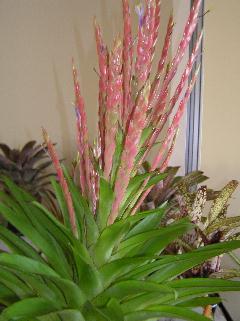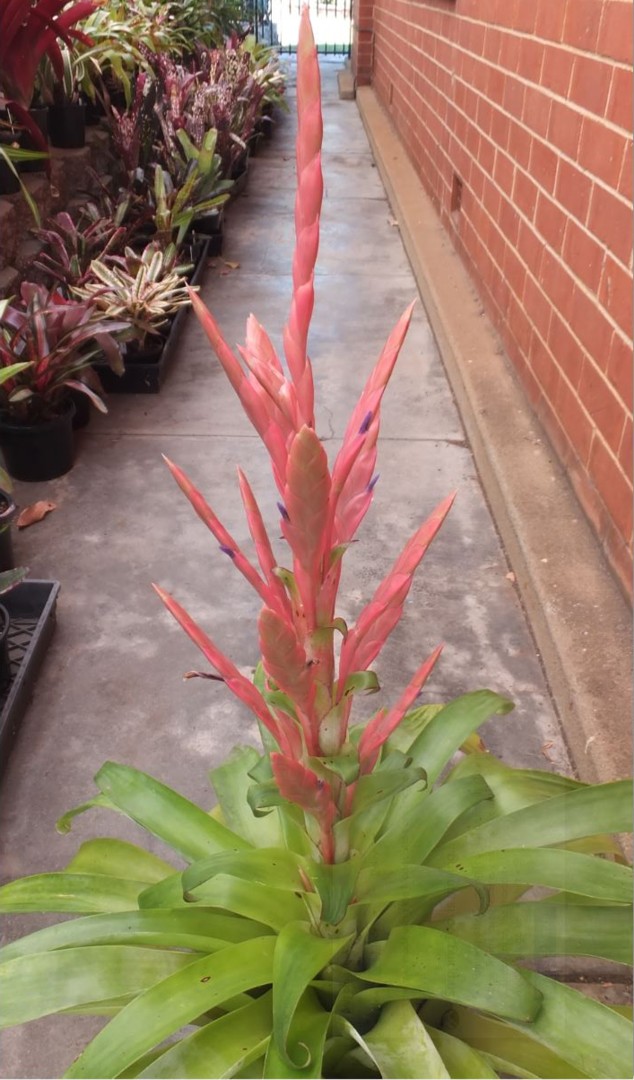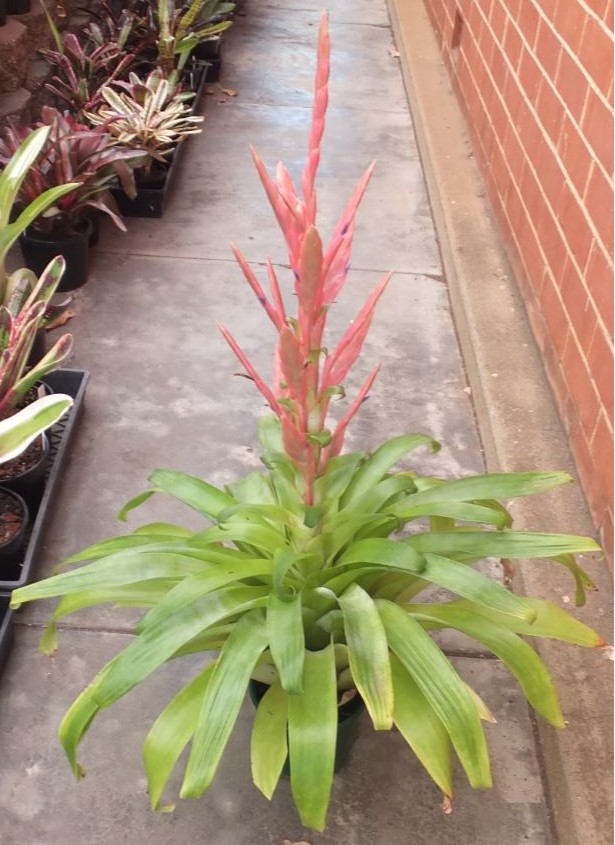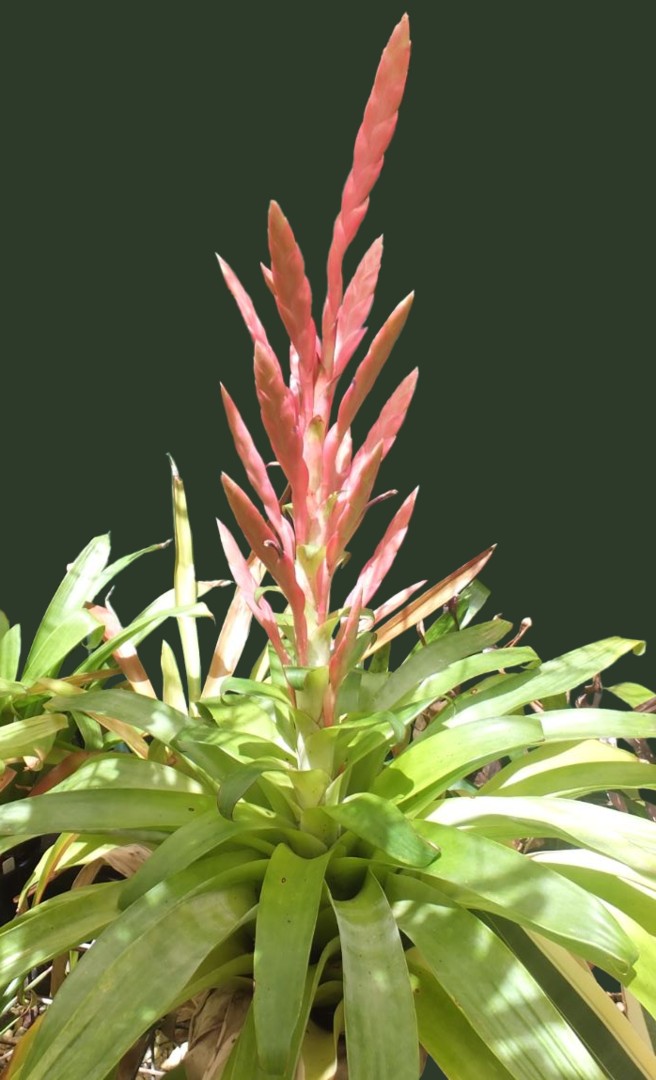



Desc from S&D p714-5
Plant stemless, flowering 8 dm high.
Leaves 20 or more in a broadly funnelform rosette, 4-5 dm long, punctulate-lepidote;
Sheaths broadly elliptic, much wider than the blades and nearly as long, greenish white;
Blades narrowly subtriangular, ca 4 cm wide, flat, green.
Scape erect, very short and completely hidden by the leaves;
Scape-bracts erect, foliaceous, very densely imbricate.
Inflorescence short-pinnate or subdigitate with the axis shorter than the erect branches, narrow;
Primary bracts subfoliaceous, covering the long largely naked sterile base of the branch;
Spike about as long as its sterile base, linear-lanceolate, acute, 9-15 cm long, 2-3 cm wide, strongly complanate.
Floral bracts imbricate but partially exposing the rhachis at least when dry, elliptic, acute, to 43 mm long, equaling or more often exceeding the sepals, sharply carinate, incurved at apex, thin-coriaceous, pale rose-pink to red, nerved when dry, glabrous outside, subdensely brown-lepidote inside;
Pedicels stout, 4 mm long.
Sepals free, linear, acute, to 37 mm long, the posterior sharply carinate;
Petals not flaccid, linear, obtuse, to 6 cm long, blue;
Stamens slightly shorter than the petals.
Capsules shorter than the sepals.
Type. Schiede & Deppe 1008 (holotype LE, US photo), Jalapa, Vera Cruz, Mexico, s n (G, Isotype ?).
DISTRIBUTION. Epiphytic in pine and deciduous forest, 1080-1800 m alt, Mexico. MEXICO. TAMAULIPAS: Gomez Farias, Sierra Madre Oriental, 22 Apr 1949, Harrell 162 (US). HIDALGO: Molango, 22 Mar 1947, Moore 2434 (BH, US). PUEBLA: Huautinango, 5 Apr 1952, Matuda 26093 (US).
Protologue
Tillandsia leiochlamys Baker, Handb. Bromel. 184. 1889. Type. Without exact locality, Mexico, Uhde 180 (B, US), 1845.
112. T. LEIOCHLAMYS Baker.
Leaves not seen. Inflorescence a flabellate panicle of 6 dense simple spikes 6-8 in. long, an inch broad; branch-bracts ovate, acute, rigidly coriaceous, lower 3-4 in. long; flower-bracts oblong, rigid, glossy, narrowed suddenly to a point, 1½-1¾ in. long, an inch broad. Sepals lanceolate, acute, an inch long. Petals not seen.
Hab. Mexico, Uhde 180 ! (Herb. Reg. Berol.). Gathered in 1846.
Tillandsia smithiana Carabia. Notes by W Till in Harvard Pap. Bot. 4(1): 223-4. 1999
In 1941 Jose Perez Carabia (1910-) described three collections from central Cuba as a new species to honor Dr. Lyman Bradford Smith (1904-1997), then member of the Gray Herbarium staff and "mayor especialista de la familia" (of Bromeliaceae). In the key (Carabia, 1941: 252) he compared his Tillandsia smithiana Carabia with T. rubra Ruiz & Pay., a name used in those days for plants we now call T. fendleri.
This history is well understood if one notices the misinterpretations by L. B. Smith of both T. paniculata Schltdl. & Cham. and T. rubra. (Smith, 1931; Smith. 1956). As both names have been linked with T. fendleri by Mez (1896,1935) and Smith (1931), and as Carabia followed the authority of Smith he had to consider his central Cuban collections to be new. It did not come to his mind to compare the Mexican species.
Carabia designated Jack 7293 in the Gray Herbarium (OH) as the type of Tillandsia smithiana (Fig. 2), while a duplicate is in the herbarium of the New York Botanical Garden (NY). Two further collections are cited in the protologue: Jack 7791 (A) and Acuna 11124 (F, HAC, both not seen) and represent paratypes. In Smith and Downs (1977) all these collections are cited under T. fendleri. However, already on 28 June 1930 L. B. Smith had annotated Jack 7293 (OH) as T. paniculata. In July 1934 he changed his determination into T. rubra. In 1940, the same sheet was annotated as “T. Smithiana Carabia 1940". No date is given for the pencil written remark of L. B. Smith: "cf. leiochlamys Bak. of Mexico".
A comparison of the holotype of Tillandsia smithiana from GH to the lectotype of T. paniculata (Schiede & Deppe, 1008) from the Komarov Botanical Institute in St. Petersburg (LE) {= T. deppeana Steud.; for wrong lectotypification by Weber (1984) see Till (1995)} immediately reveals a strong similarity. However, while in Schiede & Deppe 1008 (LE) the spike appears to be wider and shorter and the floral bracts are coriaceous and faintly nerved, the corresponding characters in Jack 7293 (GH) are: spikes narrower and longer, floral bracts more chartaceous and distinctly nerved. In all other characters both specimens are nearly identical. Additional vouchers of T. deppeana in the herbarium of the Botanical Institute of the University of Vienna (WU) as well as the paratype of T. smithiana in the herbarium of the Arnold Arboretum (A) demonstrate that the above mentioned differences are artificial and a continuous morphological series exists. Therefore, T. smithiana is synonymized as follows:
Tillandsia deppeana Steud., Nom. Bot. (ed. 2) 2: 688. 1841; nom. nov. for T. paniculata Schltdl. & Cham., Linnaea 6: 54. 1831; non L. 1762. TYPE: Schiede & Deppe 1008 (Lectotype: LE; Isolectotypes: B (2 fol.), HAL (2 fol.), KIEL, ROST).
Synonyms:
T. leiochlamys Baker, Handb. Bromel. 184. 1889. TYPE: Uhde 180 (Isotypes: B, US).
T. smithiana Carabia, Mem. Soc. Cub. Hist. Nat. "Felipe Poey" 15: 252 (key), 257. 1941; syn. nov. TYPE: Jack 7293 (Holotype: OH; Isotype: NY); Jack 7791 (Paratype: A, LE); Acuna 11124 (Paratypes: F, HAC).
Tillandsia deppeana is now known to have a disjunct distribution with the majority of its localities in east central Mexico (Smith and Downs, 1977; Espejo S. and Lopez F., 1994) and a more local distribution in Cuba. It belongs to subgen. Tillandsia which has been, according to floral characters, divided by Gardner ( 1986) into five groups; three of which are of interest here.
Of the more than 200 species of this subgenus only a few are distributed both in Mesoamerica (Mexico to Panama) and in the Greater Antilles. Most are from group 1 subgroup 1 of Gardner (1986): Tillandsia compressa Bertero ex Schult. & Schult. f., T. fasciculata with its varieties var. uncispica Mez and var. venosispica, T. polystachia (L.) L., T. schiedeana Steud. subsp. schiedeana, and T. variabilis; from group 1 subgroup 4 of Gardner (1986): T. festucoides Brongn. ex Mez and T. juncea; from group 1 subgroup 5 of Gardner (1986): T. balbisiana, T. bulbosa Hook., T. paucifolia Baker, and T. pruinosa Sw.; from group 1 subgroup 6 of Gardner (1986): T. capitata Griseb. The only species from group 2 of Gardner (1986): T. utriculata subsp. utriculata.
T. deppeana is the first case of such a disjunction for any member of group 3 of Gardner (1986).
The 14 species with the above mentioned disjunct distribution are contrasted with nine species endemic to the Greater Antilles: Tillandsia adamsii Read, T. argentea Griseb., T. ariza-juliae L. B. Sm. & J. Jimenez Alm., T. calcicola L. B. Sm. & Proctor, T. canescens Sw., T. hotteana Urb., T. moscosoi L. B. Sm., T. praschekii Ehlers & Willinger, and T. turquinensis Willinger & Michalek. Tillandsia setacea Sw. is probably subendemic to the Greater Antilles extending to southern Florida, and the localities given for Mexico are likely misidentifications of T. pseudosetacea Ehlers & Rauh (R. Ehlers, pers. comm.). Similar errors seem to be present in the cases of Mexican localities of T. fasciculata var. clavispica Mez and var. laxispica Mez.
Tillandsia flexuosa Sw. (group 2) is a species of South American origin widespread in the Greater Antilles (extending to southern Florida) but uncommon in Mesoamerica (extending to Costa Rica). It is an example for northern South American-Caribbean disjunctions which are rare in the genus.
Of the three groups of Gardner dealt with here, number 3, with two stamen series of equal length and rather long, subbasifixed anthers seems to be the most primitive, while groups 2 and 1 with stamens in two series of unequal length have derived floral morphology. Group 1 (filaments flat in cross section for entire length; corolla throat closed; more than 100 species) has its center of distribution in Mexico with many endemic species there, while some wide-spread species extend to South America and the Antilles.
Group 2 (filaments round in cross section for entire length; corolla throat open; about 22 species) has a slight majority of species in northern South America extending to the Antilles and Mesoamerica with several endemic species in both latter areas (nine in northern Mesoamerica versus two in the Antilles).
Group 3 (filaments round in cross section near apex, flat and broadened at base; corolla throat open) comprises about a dozen of species, and is of Central American distribution with Tillandsia hotteana endemic in Hispaniola and T. deppeana disjunct in east central Mexico and Cuba.
Groups 2 and 3 of Gardner (1986) have a much lower degree of Mexican-Greater Antillean disjunctions than group 1 which contains several species with great adaptive potential. Tillandsia utriculata (group 2) is widespread in the Caribbean area having three endemic derivatives: subsp. pringlei (S. Watson) C. S. Gardner in northeastern Mexico, T. socialis L. B. Sm. in southern Mexico, and T. calcicola in Jamaica. The distribution of T. flexuosa has been explained above.
Tillandsia deppeana is the only disjunct species, and T. hotteana the single Caribbean endemic species of group 3. Most species of this group are mesophytes of lower to mid-elevation humid forests. Their potential for expansion seems to be limited, only T. lampropoda L. B. Sm. and T. multicaulis Steud. extend over the whole range of the group. Group 3 of Gardner (1986) is probably a relic and its members exhibit low adaptive potential. All the more remarkable is the disjunction of T. deppeana Steud. I suggest a scenario of a primary evolution of subgen. Tillandsia in Central America with the highest degree of diversification in Mexico. Colonization of the Antilles happened primarily from the before-mentioned areas, only rarely have species arrived directly from northern South America (e.g., T. flexuosa).
From Till in Linzer biol. Beitr. 27/1: 413-421. 1995
Tillandsia paniculata SCHLECHTENDAL & CHAMISSO
Linnaea 6: 54 (1831); W. Weber, Feddes Repert. 95: 581, Abb. 3.2 (1984).
Tillandsia paniculata, {Mexico}, {Schiede & Deppe} 1008 (HAL: 2 fol., ROST, isolectotypes).
N o t e ; ROST specimen identified by the typical handwriting of A, v. Chamisso. W. Weber incorrectly has chosen the specimen in HAL as the lectotype. However, in July 1959 L.B. Smith had revised the specimen in LE as to the lectotype and published later as his only type reference. Hence the decision of Smith has to be followed. Currently treated a a synonym of Tillandsia deppeana STEUD.
PHYTOLOGIA, Vol. 5, no, 8: 394-400. June 1956
NOTES ON BROMELIACEAE, VII
Lyman B, Smith
TROPICAL AMERICA
TILLANDSIA DEPPEANA Steud. Nom. Bot, ed. 2. 2: 688. 1841.
1. Inflorescence pinnately compound, elongate.
- 2. The inflorescence only bipinnate or subtripinnate at the base.
- - 3, Leaf-blades glabrous or obscurely lepidote.
- - - 4, Spikes erect, long-stipitate => A, var. deppeana
- - - 4, Spikes spreading to decurved.
- - - - 5. The spikes straight, mostly spreading, distinctly complanate, mostly with a short sterile base. => B. var. latifolia
- - - - 5. The spikes decurved, nutant, slightly complanate, the sterile base mostly elongate => C. var. clavigera
- - 3, Leaf-blades densely cinereous-lepidote beneath; sepals only about 25 mm. long => D. var. costaricensis
- 2. The inflorescence amply tripinnate => E. var. tripinnata
1. Inflorescence simple or digitate from a few spikes => F: var. reducta
A. TILLANDSIA DEPPEANA var. DEPPEANA
T. paniculata Schlecht, & Cham. Linnaea 6: 54. 1931, not L. 1762.
T. leiochlamys Baker, Handb, Bromel, 184. 1889. (Uhde 180, Mexico).
T. paniculata var. genuina Mez in DC. Monogr. Phan. 9: 703.1896.
T. rubra sensu L. B. Smith, Contr. Gray Herb, 95: 46. 1931, not R.& P. 1802, (without varietal distinctions).
T. baliophylla Harms, Notizblatt 12: 538, 1935. (Ekman H-8308, Haiti)
T. smithiana Carabia, Mem. Soc. Cub, Hist. Nat. 15: 257. 1941. (J G Jack 7293, Cuba).
Tillandsia deppeana is a substitute name for T. paniculata Sschlecht. & Cham, which is a later homonym. Consequently it is based on the same type, Schiede & Deppe 1008, from Mexico. Not having seen this, I am interpreting the type on the basis of Mez's synonymy and citations in DC, Monogr, Phan, 9: 703, and calling it the same as Uhde 180, the type of T. leiochlamys Baker.
B. TILLANDSIA DEPPEANA var. LATIFOLIA (Griseb,) L. B. Smith, comb, nov.
T. excelsa var. latifolia Griseb, in Nachr. Ges, Wiss, Goett. for 1864; 17. 1865 (Fendler 1522, Cuba).
T. fendleri Griseb, loc. cit. (Fendler 1515, Venezuela).
T. incurvata Wright ex Sauvalle Anal. Acad. Habana 8: 54. 1871, as to material cited (Fendler 1522, Cuba), not as to basonym (Vriesia incurvata Gaud)
T. kalbreyeri Baker, Journ. Bot. 26: 45.1885 (Kalbreyer 1013, Colombia).
T. paniculata ß fendleri (Griseb.) Mez in DC Monogr Phan.9:703. 1896.
T. bangii Baker, Mem. Torrey Bot. Club 6: 154. 1896 (Bang 1283, Bolivia).
T. macrodactylon Mez, Fedde Rep. Nov. Spec 3:39. 1906 (Weberbauer 2049, Peru).
T. rubra var. fendleri (Griseb.) Mez, Pflanzenreich IV Fam. 32: 458. 1935
B. TILLANDSIA DEPPEANA var. CLAVIGERA (Mez) L. B. Smith, comb. nov.
T. clavigera Mez in DC. Monogr, Phan, 9: 783. 1896 (Steubel 208-a, Ecuador).
C. TILLANDSIA DEPPEANA var. COSTARICENSIS (Mez) L. B. Smith, comb. nov.
T. paniculata var. costaricensis Mez in DC. Monogr, Phan, 9; 703. 1896. (Oersted, Costa. Rica).
T. rubra var. costaricensis Mez, Pflanzenreich IV. Fam, 32; 458. 1935.
E. TILLANDSIA DEPPEANA var. TRIPINNATA L.B. Smith, Phytologia 5: 49. 1954. (Ferreya 9410, Peru).
F. TILLANDSIA DEPPEANA var. REDUCTA (L, B. Smith) L, B. Smith, comb, nov,
T. rubra var. reducta L, B. Smith, Fieldiana, Bot. 28, no, 1: 151. 1951, (Steyermark 60851 , Venezuela).
Protologue
1008. Tillandsia paniculata n. sp. Schlechtendal & Chamisso, Linnaea 6: 54. 1831
Folia superioris speciei, pariter at eximius obscuriusque punctata (praesertim infera vaginante parte). Caulis centralis, solitarius, foliosus, distiche ramosus, folia superans. Spicae laterales pedunculatae, anguste lanceolatae, ancipites, distichae; bracteis breviores.
- - “ Spicis e caule centrali orientibus. in arboribus parasitica. Jalapa. Aug